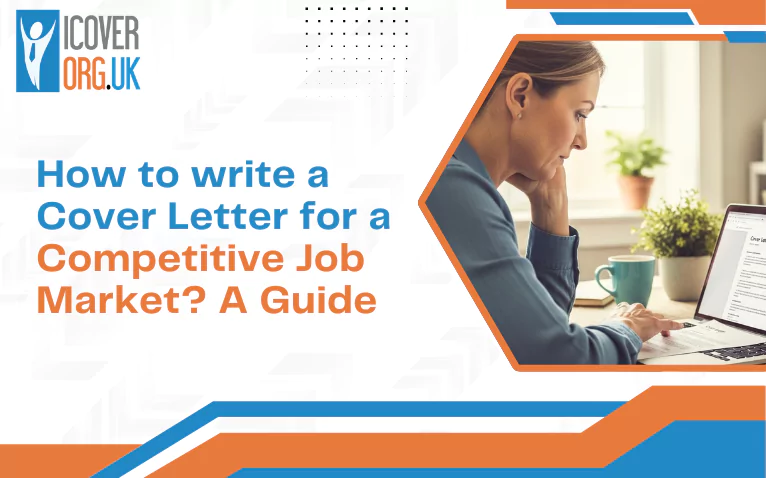In today’s fierce job market, a generic cover letter simply won’t do. With hiring managers receiving hundreds of applications for a single opening, your cover letter is your first and best chance to make a memorable impression. It is the perfect opportunity to showcase your personality, highlight your most relevant skills, and demonstrate your genuine interest in the role. This guide offers practical advice on writing a Cover Letter for competitive job market, helping you to craft a document that will capture the attention of employers and secure you that coveted interview.
What Is a Professional Cover Letter for a Job Application?
A professional cover letter is a one-page document you send with your CV when applying for a job. Its primary purpose is to introduce you, elaborate on the information in your CV, and explain why you are the ideal candidate for the position. It’s a direct communication with the hiring manager, so a professional tone and format are essential. A well-written cover letter and CV combination is your most potent tool in a job search.
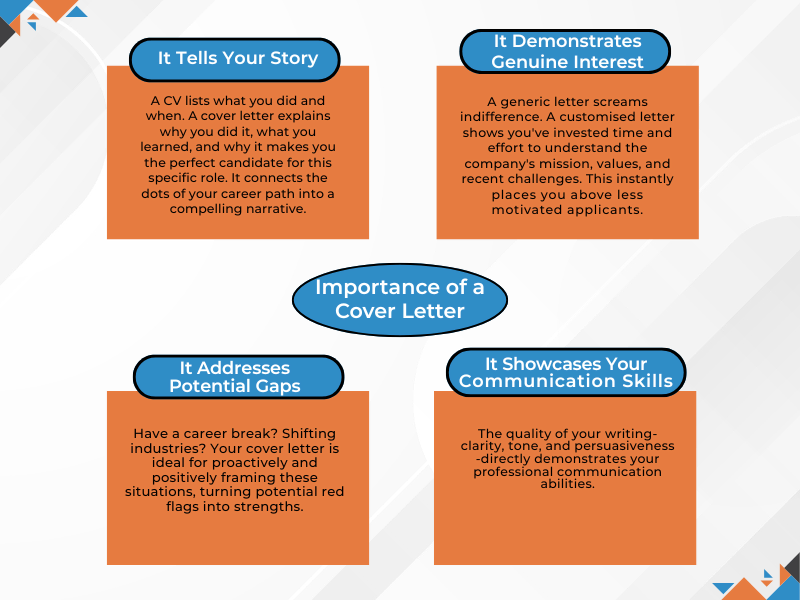
What Makes a Cover Letter Stand Out?
From an employer’s perspective, a cover letter that stands out possesses distinct features that signal a promising candidate.
- The ideal cover letter demonstrates that you have researched and understand the company’s needs.
- The ideal cover letter does not simply repeat the CV. Instead, it must present a persuasive argument for why you are the best candidate.
- Employers are looking for concrete proof of your abilities. Rather than just listing skills, a strong cover letter provides specific examples and quantifiable achievements.
- An ideal letter conveys genuine excitement for the role and the company’s mission and values.
- A cover letter is an example of your communication skills. The ideal one tends to be well-structured, clearly written, and free from spelling or grammatical errors.
- Recruiters are often short on time, so the letter must be concise and impactful. The ideal one is no more than one page, with key points presented early to grab the reader’s attention.
How to Write a Professional Cover Letter for a Job Application?
Before a single word is read, the visual presentation of your letter creates an impression. A cluttered or unprofessional layout suggests a lack of attention to detail. Writing a compelling cover letter involves thorough research, strategic thinking, and clear communication. Here are some professional cover letter writing tips to guide you:
Structure It Logically
A well-structured cover letter is easy to read and digest. A job-winning cover letter format should include:
| Structural Elements | What are things to write in a cover letter? |
| Your Personal & Contact Information (Top Right) |
|
| The Date (Below Your Contact Info) | Write the date of sending in full (e.g., 18 July 2025) |
| The Employer’s Contact Information (Left-Aligned, Below the Date) |
|
| The Salutation | Address it to a specific person whenever possible (e.g., “Dear Mr. Smith,” or “Dear Sarah Jones,”). LinkedIn or the company website is an excellent resource for finding the hiring manager’s name. If you cannot find a name, use a professional alternative like “Dear Hiring Team,”. Avoid the outdated and overly formal generic “To Whom It May Concern” or “Dear Sir/Madam.” To know more, read “How to address a cover letter without a name?” |
| The Opening Paragraph (The Hook) | Immediately state which position you are applying for and where you saw it advertised. Follow this with a powerful, engaging sentence that explains your core motivation or highlights a key achievement relevant to the role. |
| The Body Paragraphs (The Argument – 2 to 3 paragraphs) | This is the heart of your letter.
|
| The Closing Paragraph (The Call to Action) | Concisely summarise your value proposition. Reiterate your strong interest in the role and your enthusiasm for the company. Confidently state your availability for an interview to discuss how you can contribute to their team’s success. |
| A Professional Sign-off | Use “Yours sincerely” if you have a named contact or “Yours faithfully” if you do not, followed by your name. |
Write Clearly and Concisely
A good cover letter should be professionally curated and easy to read. So, what is the right way to write a cover letter? Here are some tips
- Use a standard font like Arial, Calibri, or Times New Roman in a size 10 or 12.
- Ensure there is plenty of white space to avoid a cluttered look.
- Avoid jargon and overly complex language.
- Use clear, simple sentences to convey your message effectively.
Highlight Transferable Skills
If you are changing careers or lack direct experience, focus on your transferable skills. These skills are valuable across various industries and roles, including communication, problem-solving, and leadership. You can also review our no-experience cover letter example to understand how to highlight your strengths even without formal job experience.
If you struggle to create a perfect cover letter, consider seeking professional help through iCover CV Writing Services.
What is an Example of a Cover Letter?
[Your Full Name]
[Your Address]
[Your Phone Number]
[Your Email Address]
[Link to your LinkedIn profile (Optional)]
[Date]
[Hiring Manager’s Name]
[Hiring Manager’s Job Title]
[Company Name]
[Company Address]
Dear [Mr./Ms. Last Name or First Name],
I am writing to express my enthusiastic interest in the [Job Title] position I saw advertised on [Platform where you saw the advertisement]. With a proven track record in [mention a key skill or achievement relevant to the role], I am confident that my experience aligns perfectly with the requirements of this role and your company’s objectives.
I have been following [Company Name]’s innovative work in [mention a specific project, value, or industry position] for some time, and I am particularly impressed by [mention something specific you admire about the company, showing you’ve done your research]. Your commitment to [mention a company value or mission] deeply resonates with my own professional principles.
In my previous role as [Your Previous Job Title] at [Previous Company Name], I was responsible for [describe a key responsibility and quantifiable achievement that is relevant to the new role]. For example, I [provide a specific example and quantifiable result, e.g., “successfully led a project that increased efficiency by 15%”]. My skills in [mention 2-3 key skills from the job description] are well-developed, and I am eager to apply them to contribute to your team’s success at [Company Name].
Thank you for considering my application. I am keen to learn more about this opportunity and discuss how my skills and experience can benefit [Company Name]. I am available for an interview at your earliest convenience.
Yours sincerely,
[Your Full Name]
What Does Personalising Your Cover Letter to Beat Competition Truly Mean?
Your cover letter must go above and beyond when applying for highly sought-after roles. It’s about more than just swapping out the company name. True personalisation requires deep research and strategically aligning your experience with the employer’s needs.
How to Do Proper Research?
Here are some cover letter suggestions for research to make your application stand out:
- Analyse the job description: Print the job description and highlight the key skills and requirements. Your cover letter should directly address these points, providing evidence of how you meet them.
- Research the company: Go beyond the company’s “About Us” page. Look for recent news articles, press releases, or social media posts. Mentioning a recent company achievement or project demonstrates a genuine interest in the organisation.
- Use keywords from the job description: Many companies use applicant tracking systems (ATS) to screen applications. These systems scan for keywords from the job description, so include them naturally throughout your cover letter.
Without a doubt, these cover letter tips for competitive jobs are non-negotiable for personalisation. Let’s understand how to tailor a cover letter for a tough job market using a real-life example-
Tailoring in Action
Imagine you are applying for a “Digital Marketing Executive” role at a sustainable fashion brand. The job description lists these key requirements:
- “Experience managing social media campaigns to drive engagement.”
- “Strong understanding of e-commerce platforms.”
- “A genuine passion for ethical and sustainable practices.”
The Untailored Approach (What to Avoid)
“I am a skilled Digital Marketing Executive with experience in social media and e-commerce. I am a hard worker and a team player, and I believe my skills would be a good fit for your company.”
This is generic and provides no proof.
The Tailored Approach (What to Do)
“I was excited to see the opening for the Digital Marketing Executive on LinkedIn, as I have been an admirer of [Company Name]’s commitment to circular fashion for several years.
My passion for sustainable practices drove me to lead a ‘Green Week’ campaign at my previous role at [Previous Company], where I increased organic social media engagement by 45% by focusing on the lifecycle of our products.
Furthermore, I have hands-on experience managing a Shopify Plus store, where I optimised product pages to achieve a 15% uplift in conversion rates, a skill I am confident would allow me to contribute directly to [Company Name]’s e-commerce success.”
This paragraph succeeds because it:
- Names the company and shows genuine admiration.
- Directly addresses all three key requirements from the job description.
- Uses data (45% engagement, 15% uplift) to prove effectiveness.
- Demonstrates a pre-existing alignment with the company’s core mission.
The goal is to create the perfect cover letter, not a document that feels robotic. For additional guidance on tailoring your application, expert advice on crafting a standout cover letter is valuable. Services like Cover Letter Writing Services can be a great resource.
Also, for role-specific inspiration, reviewing cover letter examples for competitive job applications, like this Cashier Cover Letter Example (click to read), can help illustrate how to connect skills to specific duties.
How Can You Write a Compelling Opening That Hooks the Reader?
Hiring managers read dozens, if not hundreds, of applications. Your first sentence must make them stop and pay attention. Writing a compelling cover letter for top jobs begins with an exceptional opening.
How do I Begin My Cover Letter?
Let’s understand this by what to avoid and what to do:
Weak Openings to Avoid
- “I am writing to express my interest in the position of…”
- “Please accept this letter as an application for the role of…”
- “My name is John Smith and I am applying for…”
These are passive, predictable, and instantly forgettable.
Strong Opening Examples
- The Passion Hook: “For the past five years, I have been dedicated to leveraging data analytics to solve complex supply chain challenges. When I saw the Senior Analyst position at [Company Name], I knew I had to apply, especially given your innovative work in predictive logistics.”
- The Achievement Hook: “In my current role as a Sales Executive, I successfully expanded my territory’s revenue by £250,000 in one fiscal year. I am confident I can bring this same drive for growth and results to your team at [Company Name].”
- The Referral Hook: “My colleague, Jane Doe, recommended I contact you regarding the Project Manager opening. Having collaborated with her on several successful projects, she believed my expertise in Agile methodologies and stakeholder management would greatly benefit your team.”
How Do You Effectively Showcase Your Skills and Achievements?
This is where you execute your cover letter strategies. The body of your letter is your chance to provide irrefutable proof of your abilities. The most powerful way to do this is with the STAR (Situation, Task, Action, Result) method, which provides a framework for storytelling with impact. Effective cover letter writing relies on evidence, not just claims.
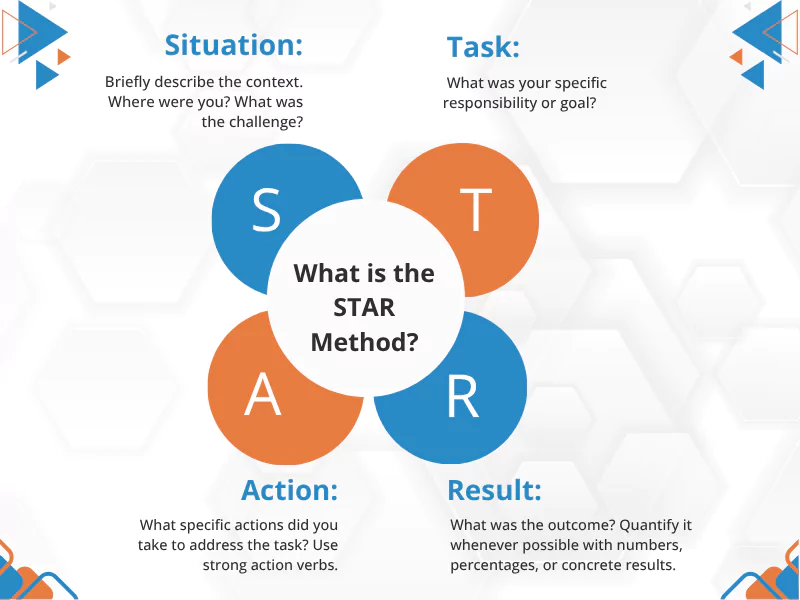
Let’s understand how to write a cover letter for competitive positions using the STAR method-
STAR Method Example (Project Manager) ✅
“At my previous company, we faced a significant challenge with project delivery (Situation).
As the lead Project Manager, I was tasked with improving our on-time completion rate, which had fallen to 70% (Task).
I initiated and implemented a new Agile workflow, introducing daily stand-ups and a Kanban board system to improve transparency and remove roadblocks proactively (Action).
Within six months, our team’s on-time project completion rate increased from 70% to 95%, significantly boosting client satisfaction scores (Result).”
How Can You Conclude for a Lasting Impression?
Your cover letter conclusion is the final note you leave with the reader. It should be confident, professional, and forward-looking. Summarise your core value, reiterate your excitement, and clarify the next step.
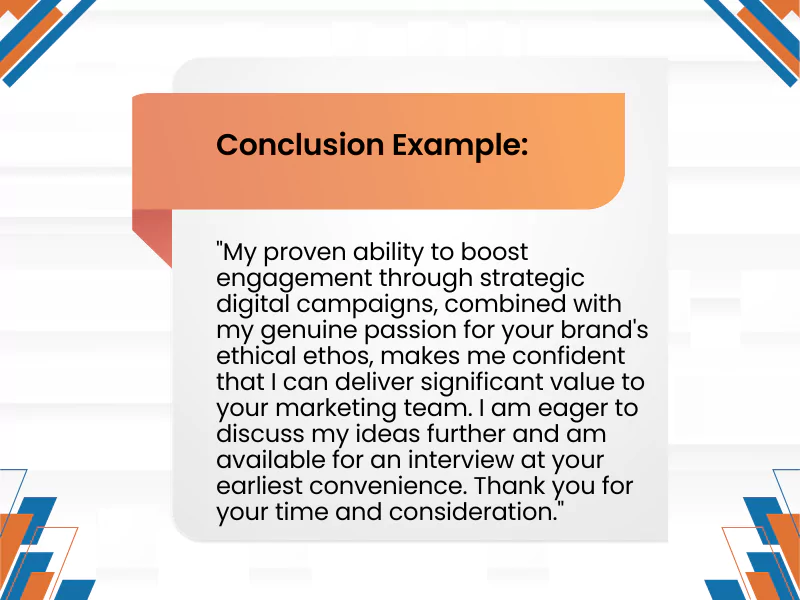
Investing this level of detail and strategic thinking, you move beyond simply applying for a job. You build a compelling business case for yourself. The ultimate goal is to impress hiring managers with your cover letter, making it impossible for them to ignore.
Crafting a standout cover letter using these Professional cover letter writing tips can put you in the limelight in a crowded field!
Why Your Cover Letter is Not Getting Noticed?
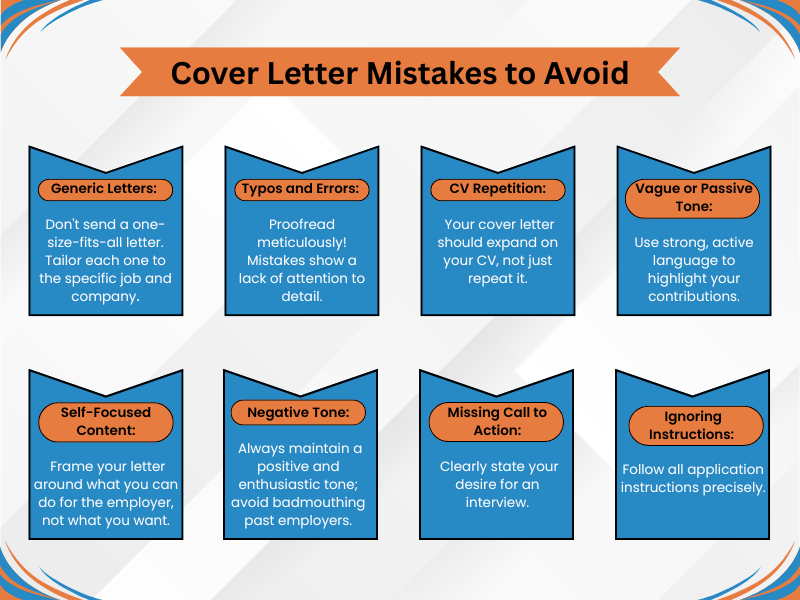
If you are not getting replies to your applications, your cover letter is letting you down. Here are some common mistakes to avoid in a cover letter for competitive roles:
- Sending a Generic, One-Size-Fits-All Letter: This is the cardinal sin. It shows a lack of effort and respect for the employer.
- Typos and Grammatical Errors: These mistakes suggest carelessness and a poor attention to detail—a highly undesirable trait in any employee. Read your letter aloud or have someone else proofread it.
- Simply Regurgitating Your CV: The letter should provide new information and context, not just re-state the bullet points from your cover letter cv combination.
- A Vague or Passive Tone: Use strong, confident language. Instead of “I was involved in…”, write “I led…”, “I created…”, “I managed…”.
- Focusing Too Much on What You Want: Frame everything around the employer’s needs. It’s not about what they can do for you; it’s about what you can do for them.
- A negative tone: Avoid negative comments about your current or former employers. Keep the tone positive and enthusiastic.
- Forgetting to Include a Call to Action: Don’t leave the hiring manager wondering what the next step is. Explicitly state your desire for an interview.
- Ignoring instructions: Pay close attention to the application instructions. If the employer asks you to include specific information in your cover letter, ensure you do so.
If you struggle with these details, iCOVER can provide the expert oversight to polish your application to perfection. Remember that your resume and cover letter for competitive fields are your entry ticket to a promising career. Make it count.
Conclusion
Writing a great cover letter for a competitive job market is about strategic communication. You create more than a document by moving beyond a generic template to personalise your content, quantify your achievements, and clearly articulate your value to the employer. You build a robust case for your candidacy. This effort transforms your application from among many into the one that secures the interview, giving you a decisive edge.
Frequently Asked Questions
What is proper formatting for a cover letter?
For a formal UK cover letter, left-align your text and use single spacing with a blank space between paragraphs. A professional font such as Calibri or Arial in a size 10-12 ensures readability. Place your contact details in the top right-hand corner, followed by the recipient’s details on the left, slightly lower down. Always address it to a specific person (e.g., ‘Dear Mr Smith’) rather than using a generic ‘Dear Sir/Madam’.
What are dos and don’ts with a cover letter?
- Do: Show you’ve researched the company by mentioning a recent project or company value, address any potential concerns in your CV (like a career gap) proactively, and use positive, confident language.
- Don’t: Lie or exaggerate your skills, focus on what the company can do for you, or use an informal tone or clichés. For more info, read “Top cover letter mistakes that can be avoided”.
How do I write a short cover letter?
For a short cover letter, adopt the “elevator pitch” approach. Start by immediately stating your purpose. Dedicate the core of the letter to one powerful paragraph that showcases your single most relevant skill or achievement, supported by a specific, quantifiable result. Conclude swiftly by reiterating your suitability and expressing your eagerness for a discussion.
What is the first sentence of a cover letter?
The first sentence should be direct and engaging, establishing your connection to the role. Instead of a passive opening, try a hook that shows your enthusiasm or a direct link to the company, for example: “Having followed [Company Name]’s pioneering work in [industry/field], I was thrilled to see the opening for a [Job Title] on [Platform].”
What is the 3-paragraph structure of a cover letter?
This structure ensures a logical flow from the introduction to the conclusion.
- The Opening: State the role you’re applying for and where you found it, and express your immediate, genuine interest.
- The Argument: This is your sales pitch. Provide specific examples and evidence of how your skills and experience meet the top requirements listed in the job description.
- The Close: Summarise your value, reiterate your strong interest in the company itself, and finish with a proactive call to action.
What is the rule of 3 in a cover letter?
The “rule of 3” suggests focusing your cover letter on three key things. This can be three of your most relevant skills, three key achievements from your career that align with the role, or a three-paragraph structure. This structure helps keep your letter concise, impactful, and easy for the recruiter to digest.
How useful was this post?
Click on a star to rate it!
Average rating / 5. Vote count:
No votes so far! Be the first to rate this post.
We are sorry that this post was not useful for you!
Let us improve this post!
Tell us how we can improve this post?
Want To See My Profile — Click Here Taylor
- Need a First Time Job Cover Letter Example? Here’s What Works! - December 11, 2025
- How to End a Cover Letter: Step-by-Step Guide to Close a Cover Letter - October 29, 2025
- Get Hired Fast! CV Example for 16 Year Olds + CV Template Inside - October 16, 2025

